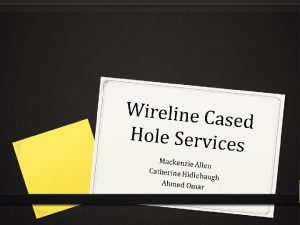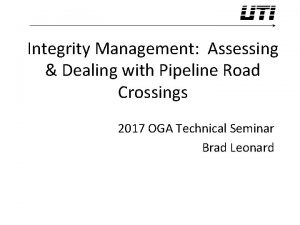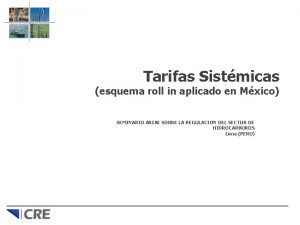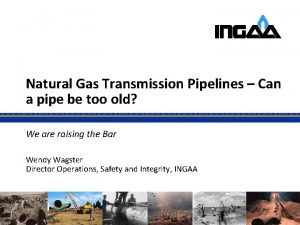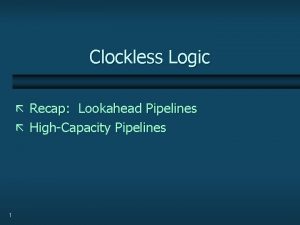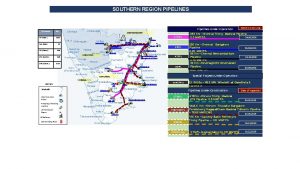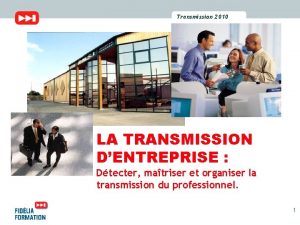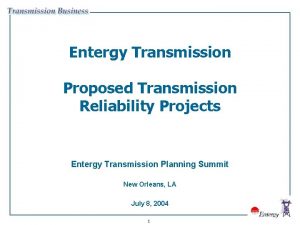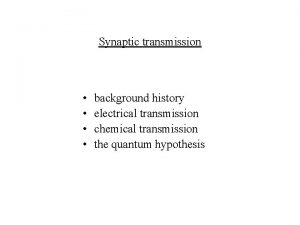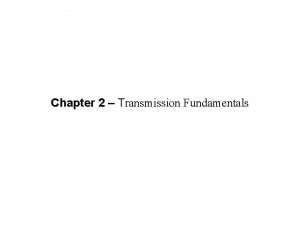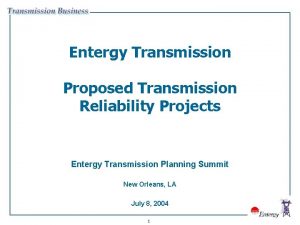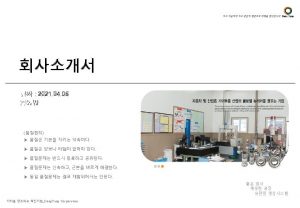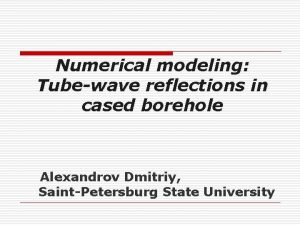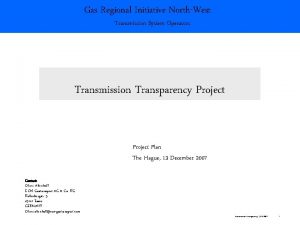ECDA Process for Cased Gas Transmission Pipelines Charlie




























- Slides: 28

ECDA Process for Cased Gas Transmission Pipelines Charlie Hall Manager, Special Projects Mears, CPG

Objectives • Review the ECDA Process From a Technical and Regulatory Perspective • Review On-Going Validation Efforts and our Casing Test Facility

Technical Basis of the ECDA Process for Cased Pipelines • Fundamentally the ECDA process seeks to determine if a corrosive situation potentially exists in the casing. – – Anode Cathode Metallic Path Electrolytic Path • If the coating is free of holidays, an external corrosion cell cannot occur (absent disbonded coating issues). • If a holiday is present, the highest risk of external corrosion occurs when the holiday is in contact with electrolyte.

Technical Basis of the ECDA Process for Cased Pipelines • If electrolyte is in contact with the holiday and the casing, indirect inspection tools can detect the holiday. Additionally, the holiday would be in the CP circuit and may be receiving adequate CP. • If the casing is metallically shorted, the holiday will likely not receive any available CP. Available CP will seek the path of lowest resistance, which most likely is the metallic contact. • These same principles apply to buried un-cased piping.

Technical Basis of the ECDA Process for Cased Pipelines • Situations that cause external corrosion in cased pipelines – Metallic contact between casing and pipeline – Electrolytic contact between casing and pipeline – Atmospheric Corrosion on pipeline in casing Reference GRI-05/0200 “External Corrosion Probability Assessment for Carrier Pipes Inside Casings” Casing Corrosion Direct Assessment – ECDA Larry G. Rankin and Hussain M. Al Mahrous January 2005

Principles of ECDA Process Development • ECDA is a structured process that is intended to improve safety by assessing and reducing the impact of external corrosion on pipeline integrity. • ECDA is a continuous improvement process targeted to identify and address locations where corrosion activity has occurred, is occurring, or may occur.

DOT Code Requirements for the ECDA Process • Per DOT Part 192. 921, DA can be used to assess the integrity of gas transmission pipelines for the external, internal, and SCC. • Per DOT Part 192. 921, DA must be performed in accordance with 192. 923, 192. 925, 192. 927, and 192. 929, and specifically ECDA in accordance with NACE RP 0502.

Application of NACE RP 0502 to Cased Gas Transmission Pipelines • Per NACE RP 0502, Table 1, Cased crossings requires a separate ECDA region. • Per NACE RP 0502, Table 2, indirect testing methods are “applicable” for shorted casings. • Per NACE RP 0502, Table 2, indirect testing methods for cased piping are “Not Applicable: Not applicable to this tool or not applicable without additional considerations. • The ECDA Process we have developed for Cased Piping addresses the NACE RP 0502 requirement for “additional consideration” and fully complies with DOT part 192 and NACE RP 0502 protocols.

• Mears solicited a clarification to footnote #3 Table 2 from PHMSA • Quote from that clarification – one bullet second clarification include in regards to footnote #3 • Answer B – is intended to assess the integrity of the pipe including cased pipelines

The ECDA Process for Cased Pipelines • The Cased Pipeline ECDA Process looks to find areas where corrosion may have or may be occurring, just like the ECDA process for buried uncased pipelines. • The Cased Pipeline ECDA Process uses the same 4 steps as used for buried uncased pipelines.

The ECDA Process for Cased Pipelines • The Cased Pipeline ECDA Process meets the same protocol requirements as for buried uncased pipelines (ie. immediate, schedule, monitored conditions, minimum excavation requirements, etc. ). • The Cased Pipeline ECDA Process utilizes Guided Wave Ultrasonic Inspection as an additional Indirect Inspection Tool concurrent with ALL Direct Examinations. • The Cased Pipeline ECDA Process is being designed using the knowledge gained from the smart pig results of 1201 cased pipelines • The process is being validated both in the field and using a newly constructed Casing Test Bed

Pre-Assessment • Collect all required data elements (additional elements have been identified for cased pipelines) • Must be Feasible to perform ECDA on cased pipeline – Must be able to indirectly examine – Must be able to directly examine both ends (if necessary) and comply with all of the PHMSA guided wave target items – Must establish meaningful segments and regions for cased pipelines that pass the “red face test”

Indirect Inspection Indirect inspection tools can detect metallic or electrolytic shorted conditions • • PCM (NACE RP 0502) PCM with A-FRAME (NACE RP 0502) P/S & C/S Potentials (including CIS both sides) Internal Resistance (NACE RP 0200) Cycling the Rectifier (NACE RP 0200) Pipe/Cable Locator (NACE RP 0200) Panhandle Eastern Method (AGA) Has the ability to detect corrosion wall loss • Guided Wave (Guided Wave UT Target Items)

Are Tools Complimentary? • The word complementary can mean different things to different people. • Typically “complimentary” suggests something that adds value, reinforces, or supplements something else. • When someone says you and your spouse compliment one another, it suggests that the two of you are better as a whole, and you make up for each others’ strengths and weaknesses.

Are Tools Complimentary? • The IITs for Casings are complimentary. • The tools look for the same potential corrosive conditions, but they do so in slightly different manners. • This can help to account for the strengths and limitations of each tool. • This is also true for the IITs that are used to assess buried pipelines.

Indirect Inspection Severity Guide CASED PIPELINE INDIRECT INSPECTION METHOD INDICATIONS & SEVERITY GUIDE TYPE OF TOOL MINOR (NO PATH INDICATED) MODERATE (ELECTROLYTIC PATH) SEVERE (METALLIC CONTACT) P/S & C/S POTENTIALS ELECTRICAL POTENTIAL P/S & C/S "ON" DIFFER BY MORE THAN 100 m. V P/S & C/S "ON" DIFFER BY 10 m. V TO 100 m. V P/S & C/S "ON" DIFFER BY LESS THAN 10 m. V PIPE CURRENT MAPPER AC CURRENT ATTENUATION CURRENT LOSS ACROSS CASING < 5% CURRENT LOSS ACROSS CASING 5%-25% CURRENT LOSS ACROSS CASING > 25% PCM WITH A-FRAME AC VOLTAGE GRADIENT NO INDICATION AT EITHER END INDICATION < 80 d. Bm. A INDICATION > 80 d. Bm. A INTERNAL RESISTANCE ELECTRICAL RESISTANCE PIPE-TO-CASING RESISTANCE > 0. 5 OHM P-C RESISTANCE 0. 01 TO 0. 5 OHM P-C RESISTANCE < 0. 01 OHM CYCLING THE RECTIFIER COMPARE P/S & C/S POTENTIAL SHIFTS >100 m. V DIFFERENCE C/S SHIFT < 25% P/S SHIFT 10 m. V-100 m. V DIFF. & C/S 25%-75% OF P/S SHIFT < 10 m. V DIFF. & C/S > 75% OF P/S SHIFT PIPE/CABLE LOCATOR RADIO SIGNAL NO SIGNIFICANT SIGNAL LOSS MODERATE SIGNAL LOSS NEAR TOTAL SIGNAL LOSS PANHANDLE EASTERN METHOD REVERSE CURRENT APPLIED TO CASING ADDITIONAL TESTING REQUIRED TO DEFINE PIPE-TO-CASING RES. < 0. 01 OHM CASING/PIPE CAPACITANCE TINKER & RASOR MODEL CE-IT "CLEAR" DISPLAY NONE "SHORTED" DISPLAY COMMON NAME OF TOOL

Indirect Inspection Classification of Indirect Inspection Testing Indirect Inspection Results 1 For DE Prioritization Any indication of a Metallic Short or Electrolytic Path Immediate NO indication of either a Metallic Short or Electrolytic Path Monitored 1 casings that were identified with some history of either a Metallic Short or Electrolytic Path but are not presently indicating the same , the DE Priority will be moved to the Immediate category and require direct examination during the first application of the ECDA process. .

Direct Examination • Must be performed per NACE RP 0502. • Minimum direct examinations per NACE RP 0502 protocols (ie. All immediates, 2 worst case monitored for 1 st time through) • Guided Wave ultrasonic indirect inspections must be performed during all Direct Examinations. Any metallic shorts or indications of electrolytic paths must be cleared prior to inspection.

Direct Examination • Guided Wave must comply with all of the PHMSA Guided Wave Target Items, or exceptions documented with technical basis.

Post Assessment • Must comply with NACE RP 0502

Summary of Smart Pig Results • 1201 cased pipelines smart pigged from 2004 to 2006. • 144 of the 1201 cased pipelines (12%) had anomalies with metal loss detected > 20%. • 20 of the 144 cased pipelines with metal loss >20% (1. 6 % of all cased pipelines) were found with anomalies > 80 feet from the nearest end of the casing.

Summary of Smart Pig Results • The lowest Pf/MAOP for any anomaly was 1. 67, and the anomaly was within. 1 feet of the end of the casing. • The lowest Pf/MAOP for all anomalies > 80 feet from the end of the casing was 1. 79 (anomaly 27% deep, 5. 3” long). • The results strongly suggest that external corrosion is not a significant threat to cased pipelines.

Validating the Process - Casing Test Facility

Validating the Process Casing Test Facility


Example of IIT Results on Casing Test Facility - PCM North South Distance 7 Clear 0 Condition Simulated Actual Elect Short Metallic Elect Short 100 ft 231 760 1700 482 50 ft 217 680 1550 471 0 ft 194 593 1340 395 0 ft 191 231 0 218 50 ft 152 149 0 146 100 ft 104 89 0 80 All readings in milli-amps, out of a total of 2 amps PCM A-Frame detected location of 20%, 50%, and 80% anomalies in shorted conditions

Summary • The ECDA process and the NACE RP 0502 is applicable to cased pipelines. • The process will improve the safety of cased pipelines by identifying when potential corrosive conditions occur, requiring direct examinations and remediation, in the same manner as required when applying ECDA on buried pipelines. • The process will continue to improve, as the tools and the process are continually improved.

Comments/Discussion Thank You Charlie Hall
 Production wireline and cased hole services group
Production wireline and cased hole services group Cased pipeline crossings
Cased pipeline crossings Westwood pipelines
Westwood pipelines Ammonia pipelines
Ammonia pipelines Teppco pipeline map
Teppco pipeline map Updm pipelines
Updm pipelines Edge to core to cloud data pipelines
Edge to core to cloud data pipelines Pipelines
Pipelines Agt informational postings
Agt informational postings Ideal gas vs perfect gas
Ideal gas vs perfect gas Imaginary gas
Imaginary gas Differences between ideal gas and real gas
Differences between ideal gas and real gas Ideal gas vs perfect gas
Ideal gas vs perfect gas Conclusion of bhopal gas tragedy
Conclusion of bhopal gas tragedy Gas leaked in bhopal gas tragedy
Gas leaked in bhopal gas tragedy Volume molare
Volume molare Flue gas desulfurisation gas filter
Flue gas desulfurisation gas filter Poisonous gas leaked in bhopal gas tragedy
Poisonous gas leaked in bhopal gas tragedy Difference between ideal gas and real gas
Difference between ideal gas and real gas Persamaan arrhenius
Persamaan arrhenius Gas exchange key events in gas exchange
Gas exchange key events in gas exchange Fspos
Fspos Typiska novell drag
Typiska novell drag Nationell inriktning för artificiell intelligens
Nationell inriktning för artificiell intelligens Vad står k.r.å.k.a.n för
Vad står k.r.å.k.a.n för Varför kallas perioden 1918-1939 för mellankrigstiden
Varför kallas perioden 1918-1939 för mellankrigstiden En lathund för arbete med kontinuitetshantering
En lathund för arbete med kontinuitetshantering Underlag för särskild löneskatt på pensionskostnader
Underlag för särskild löneskatt på pensionskostnader Personlig tidbok
Personlig tidbok
